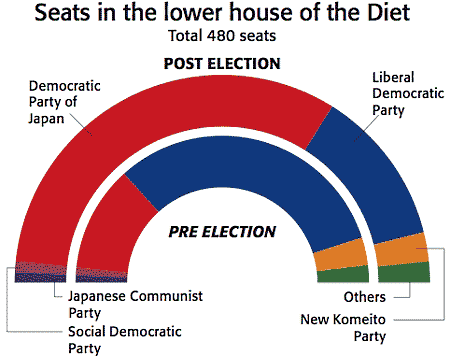
The Japanese recently voted to oust the LDP, which has governed since 1955. So what can Japan, and the rest of the world, expect from its successor, the DPJ? Cris Sholto Heaton reports.
What’s changed in Japan?
The recent general election saw a huge shift in Japanese politics. The Liberal Democratic Party (LDP) was defeated by the opposition Democratic Party of Japan (DPJ).
The LDP has ruled Japan for all but 11 months since 1955 – and the brief period out of power in 1993-1994 was the result of a split within the party, rather than them being turfed out by the electorate. But now it’s been reduced to a rump, shedding more than 180 of its seats in the lower house of the legislature, or Diet (see chart above).
How did the LDP last so long?
Because initially its policies were extremely successful. A unique system of close co-operation between the LDP, the bureaucracy and the keiretsu (groups of interconnected companies) delivered decades of strong growth, turning Japan from a post-war wreck into the world’s second-biggest economy.
The limited need for change was satisfied by shifts in the balance of power between different factions in the party. That began to fall apart after the bubble and crash of the late 1980s; but even then, the LDP’s enormous fiscal stimulus programmes ensured it continuing support in rural areas and from industries such as construction.
The rise of the charismatic and popular prime minister Junichiro Koizumi then gave the party a new lease of life early in this decade. But after he stepped down in 2006, the LDP ran through three leaders in as many years. It lost its majority in the less-powerful upper house of the Diet in 2007 and now voters have evicted it from office altogether.
Why have the voters lost patience?
The economy undoubtedly played a part. Everyone is now familiar with the story of Japan’s ‘lost decade’ (now approaching 20 years) since the bubble burst. Still, the situation is often exaggerated by Western commentators.
Yes, it’s been a lousy time for investors: stocks are back at 1985 levels and land prices are off by 50% from the peak. But Japan remains a wealthy, innovative and exciting country, not an economic slough of despond. As much as anything else, voters were simply tired of the LDP and the uninspiring succession of hapless prime ministers who followed Koizumi and they wanted a change.
Will they get one?
Perhaps. It has to be said that the leaders of the DPJ are not exactly revolutionaries. Party leader Yukio Hatoyama comes from a typical Japanese political dynasty. His grandfather was the founder of the LDP (along with the grandfather of Taro Aso, the incumbent prime minister he has just defeated).
Another influential figure is Ichiro Ozawa, who was DPJ leader until he stepped down over the arrest of a close ally in a fundraising scandal earlier this year.
Both men are ex-LDP members and were both part of the short-lived 1993 government. Indeed, it’s worth remembering that the transfer of power to their coalition back then was expected to reform politics, something that it clearly failed to do.
Still, on paper at least, the DPJ is proposing a significant break with its predecessor’s policies.
What’s the DPJ’s manifesto?
It has pledged to move away from the infrastructure spending binges that combined fiscal stimulus with pork-barrel patronage for LDP voters. Instead, it will increase healthcare spending, attempt to boost birth rates through childcare support and cut taxes on small business.
Optimists hope this will boost consumer spending. Less positively, Hatoyama has said that he may remove some of the labour market flexibility brought in by Koizumi, with measures such as a ban on factories hiring temporary workers.
The DPJ also intends to reform the bureaucracy and end the common and corrupt practice of amakudari, or ‘descent from heaven’, in which senior bureaucrats retire to top positions in the industries they’ve been regulating.
In foreign policy, the new government may weaken ties with the US and improve relations with the rest of Asia. It remains to be seen if these promises will be honoured.
What might go wrong?
The DPJ’s manifesto disguises a party that has been held together more by a desire to evict its rival than any coherent ideology. This fact is not lost on voters, who were clearly voting against the LDP rather than endorsing the DPJ. It’s possible that in power it will either succumb to infighting or just be content to let the status quo persist.
What’s more, there is an elephant in the room in the shape of Japan’s enormous public debt (more than 200% of GDP), which must begin to constrain the government’s options soon. The DPJ has tried to sound a tough note on reducing the budget deficit, but has not presented any real plan for cutting the mountain down to size.
Still, there is at least a genuine chance for a major shake-up, not least because the LDP must now reinvent itself as an effective opposition if it is to have any prospect of regaining power.